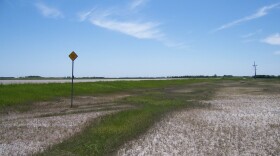The landscape has been changing from brown to green, and for the casual observers, most of that fresh green color is often largely attributed to grass growth. But it might not all be what it seems. Much of that new green growth, particularly in the wetter habitats may not be grasses but sedges, a group of plants that are not well known.
Sedges are cool-season grass-like plants. Like the cool-season grasses (for example the Kentucky bluegrass in your yard) sedges grow early in the cooler days of spring and early summer. They do not grow as much during the warmer days of summer, but if conditions are good, they may have another spurt of growth in the cool days of fall.
Sedges are members of the Cyperaceae family, which also includes bulrushs and spikerushes. The Carex genus is considered to be the largest genus of vascular plants in North America. Worldwide, there are over 1,500 species, and around 60 species have been documented in North Dakota. Most sedges are species of wetlands and wet meadows, but they can also be found in grasslands as well as forested areas, particularly in heavily shaded areas.
At a distance, grasses and sedges can be rather difficult to differentiate. But a closer look will reveal that unlike grasses which have round stems, sedges have triangular stems. As the saying goes, “sedges have edges.” If you roll the stem of a grass in your fingers it will roll easily. If you roll the stem of a sedge in your fingers you should be able to feel the edges. Another helpful characteristic is that the leaves of a grass are produced alternately up and down the stem, coming off on opposite sides. The leaves of sedges are produced on all three sides of the stem. They also often originate near the base of the stem.
Like the grasses, sedges are wind pollinated, so do not produce showy flowers, nectar, and fragrance. However, they can add interesting structure and color to plantings. And sedges along with grasses are increasingly of interest to gardeners and landscapers. Plus, there is also increased interest in planting native plants. You may want to consider checking with your local greenhouse or nursery to see if they have some native sedges for sale.
—
Further Reading





